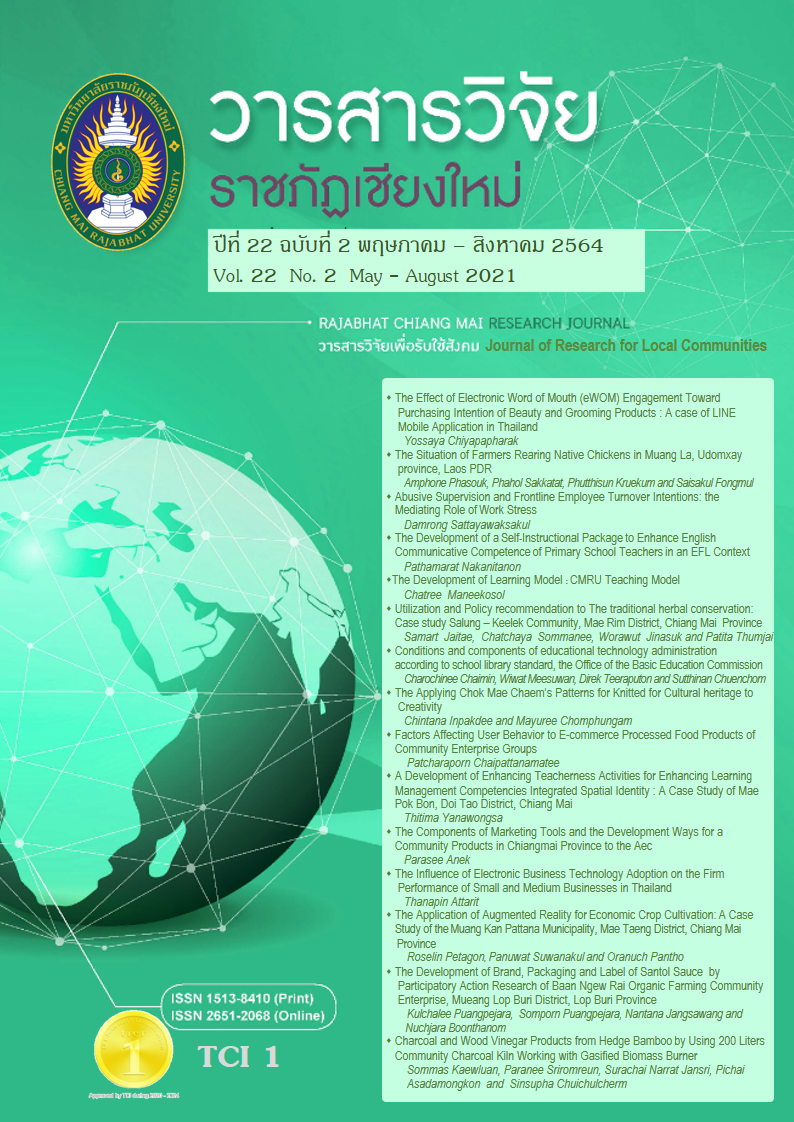การพัฒนาแอปพลิเคชันความเป็นจริงเสริมเกี่ยวกับการเพาะปลูกพืชเศรษฐกิจ กรณีศึกษาพื้นที่เทศบาลเมืองเมืองแกนพัฒนา อำเภอแม่แตง จังหวัดเชียงใหม่
DOI:
https://doi.org/10.14456/rcmrj.2021.246915คำสำคัญ:
ความเป็นจริงเสริม, การเพาะปลูกพืชเศรษฐกิจ, แอปพลิเคชันบทคัดย่อ
งานวิจัยครั้งมีวัตถุประสงค์ 1) เพื่อพัฒนาแอปพลิเคชันความเป็นจริงเสริมเกี่ยวกับการเพาะปลูกพืชเศรษฐกิจ และ 2) เพื่อศึกษาความพึงพอใจของผู้ใช้แอปพลิเคชันความเป็นจริงเสริมเกี่ยวกับการเพาะปลูกพืชเศรษฐกิจ ผู้เชี่ยวชาญที่ใช้ในประเมินประสิทธิภาพได้มาโดยวิธีการคัดเลือกแบบเจาะจงจำนวน 5 คน กลุ่มตัวอย่างที่ใช้ในการศึกษาความพึงพอใจได้มาโดยวิธีการสุ่มจำนวน 30 คน เครื่องมือการวิจัยได้แก่แอปพลิเคชันความเป็นจริงเสริมในการเพาะปลูกพืชเศรษฐกิจ แบบประเมินประสิทธิภาพของแอปพลิเคชัน และแบบสอบถามความพึงพอใจแบ่งเป็น 3 ด้านได้แก่ ด้านความสมบูรณ์ของเนื้อหา ด้านการออกแบบ การจัดรูปแบบและการนำเสนอข้อมูลและด้านประโยชน์ต่อการนำไปใช้งานของเทคโนโลยี AR สำหรับสถิติที่ใช้ในการวิเคราะห์ได้แก่ ค่าเฉลี่ย ส่วนเบี่ยงเบนมาตรฐาน ผลการวิจัยพบว่าผู้เชี่ยวชาญและกลุ่มตัวอย่างมีค่าการประเมินประสิทธิภาพและการประเมินความพึงพอใจมากที่สุด คือด้านประโยชน์ต่อการนำไปใช้งานของเทคโนโลยี AR ค่าเฉลี่ยเท่ากับ 4.76 ส่วนเบี่ยงเบนมาตรฐาน 0.42 และมีค่าเฉลี่ยเท่ากับ 4.45 ส่วนเบี่ยงเบนมาตรฐาน 0.57 ตามลำดับ
Downloads
เอกสารอ้างอิง
Limpinan, P. (2019). Promoting Mahasarakham Tourism by using Augmented Reality. Journal of Project in Computer Science and Information Technology, 6(1), 8-16. (in Thai)
Meesuwan W. (2011). Augmented Reality Technology for Learning. Journal of Education Naresuan University, 13(2), 119-127. (in Thai)
Nitiyuwit, T., & Kumtapol Y. (2019). The Tourism Promotion Application of 6 Souvenirs that Need to Purchase in Phetchabun Province with the Augmented Reality Technology. Journal of Information Technology Management and Innovation, 6(1), 179-189. (in Thai)
Oakkarawong, P., & Samat C. (2016). The Effects Design and Development of Constructivist Augmented Reality Learning Environment to Promote Analytical Thinking on Topic Implementation of Computer Softwarefor Grade 8 Students. Journal of Information Technology Management and Innovation, 10(3), 181-190. (in Thai)
Office of Agricultural Extension and Development. (2020). Information from the Office of Agricultural Economics. Retrieved from http://www.ndoae.doae.go.th/plant-unity1.php (in Thai)
Sahapong, T. (2019). The Development of Augmented Reality Application “Sadue E-San”, Kosum Phisai District, Maha Sarakham Province. Sripatum Review of Science and Technology, 11(1), 139-151. (in Thai)
Siriwan, W. (2010). A study of the satisfaction of learners towards teaching and learning activities in mathematics By using evaluation techniques in class. Journal of Rangsit University : Teaching & Learning, 4(2), 24 – 37. (in Thai)
Sricharoen, J. Siharad, D., & Sukparsert, A. (2019). The Tourism Promotion Appcation of 8 Attractions that Need to go to in Phetchabun Province with the Augmented Reality Technology. Journal of Project in Computer Science and Information Technology, 5(1), 84-94. (in Thai)
Sincharu, S. (2014). Research and Statistical Data Analysis With SPSS and AMOS. Bangkok: business r&d ordinary partnership. (in Thai)
Techakosit S. & Nilsook P. (2018). Augmented Reality in a Junior High School Science Textbook Based on the Learning Model of Scientific Imagineering in Order to Enhance STEM Literacy. E-Journal of Media Innovation and Creative Education, 1(2), 38 – 47. (in Thai)
Tunsiri, P. (2010). Augmented Reality. Executive Journal. 30(2), 169-173. (in Thai)
ดาวน์โหลด
เผยแพร่แล้ว
รูปแบบการอ้างอิง
ฉบับ
ประเภทบทความ
สัญญาอนุญาต
1. บทความ ข้อมูล เนื้อหา รูปภาพ ฯลฯ ที่ได้รับการตีพิมพ์ใน “Community and Social Development Journal” ถือเป็นลิขสิทธิ์ของ Community and Social Development Journal มหาวิทยาลัยราชภัฏเชียงใหม่ และเพื่อให้เผยแพร่บทความได้อย่างเหมาะสมผ่านสื่อสิ่งพิมพ์และอิเล็กทรอนิกส์ ผู้เขียนยังคงถือครองลิขสิทธิ์บทความที่ตีพิมพ์ภายใต้ใบอนุญาต Creative Commons Attribution (CC BY) ซึ่งอนุญาตให้เผยแพร่บทความซ้ำในแหล่งอื่นได้ โดยอ้างอิงต้องอ้งอิงบทความในวารสาร ผู้เขียนต้องรับผิดชอบในการขออนุญาตผลิตซ้ำเนื้อหาที่มีลิขสิทธิ์จากแหล่งอื่น
2. เนื้อหาบทความที่ปรากฏในวารสารเป็นความรับผิดชอบของผู้เขียนบทความโดยตรง ซึ่งกองบรรณาธิการวารสารไม่จำเป็นต้องเห็นด้วยหรือร่วมรับผิดชอบใดๆ














